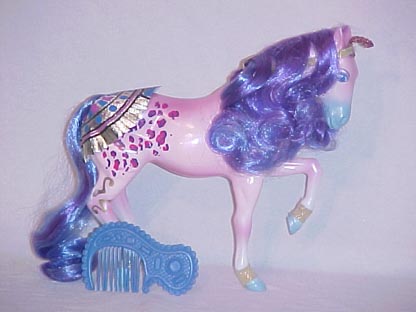Royal Beauties

Cleo
Cleo is a fleshy pink with darker tones at her
back and knees. Her muzzle and hooves are pale blue. She has dark pink leopard spots
with purple outlines on her rump. These also occur on her cheeks. She has
gold squiggle lines on her back legs. Her mane and tail are a thorough mix
of dark blue and purple.
Accessories
"The tail-skirt is an Usekh, pronounced Ooosek, which translates as the Broad One to distinguish it from other types of collar traditionally worn in Ancient Egypt. It developed from a twisted handful of waterweed worn by boatmen and fishermen to keep cool while working on the Nile, and therefore often has floral motifs but was made of beads of precious and semi-precious stones, gold, or faiance, a type of glazed ceramic which allowed very bright colors to be made, most typically in blue to imitate the night sky. The collar was worn in various forms by all segments of Egyptian society, from Pharaoh to peasant, with the basic design of the broad collar held on by a weighted counterpoise being the same, only the materials differing. The collar was a sacred symbol of the goddess Hathor, goddess of music, beer and love and has become an ubiquitous emblem of everything Egyptian, having been present throughout the 4000-year Pharaonic period.
The rearing cobra, or Uraeus (yooo-ray-us) was the representation of the goddess Wadjet, protectress of the crown of Egypt and the king's body as a god. It was only ever worn by Pharaohs, with the exception of a very few and particularly honored queens. The uraeus, when found on a coffin, indicates royal contents except in the period in which Egypt was under Roman rule after the death of Cleopatra, when generalized Egyptian motifs were adopted indiscriminately by a ruling elite who didn't understand their symbolism. The cobra, raised to spit fire at the king's enemies, was an integral part of royal regalia, and was always depicted in gold, as this was believed to represent the flesh of the gods with their bones being silver.
The name Cleo is a reference to Cleopatra, the last queen of Egypt, and actually the seventh of that name. Despite being possibly the most famous queen of Egypt, she was in fact a Greek, and the first of a line of Greek Pharaohs to learn the native Egyptian language. But then again they could hardly call a filly Hatshepsut or Ankhsenamun, could they........" Thanks to Beverley C. for this information!

